- mdpi.com
- europepmc.org
- wikiskripta.eu
- HENEŠOVÁ, Judita - JABLONSKÝ, Peter. 2013. Movement System and Regenerative Exercises, [1st ed.]. Bratislava: Metodicko-pedagogické centrum, 2013. 64 s. ISBN 978-80-80-8052-476-0
Back exercises. How to properly strengthen the back muscles?
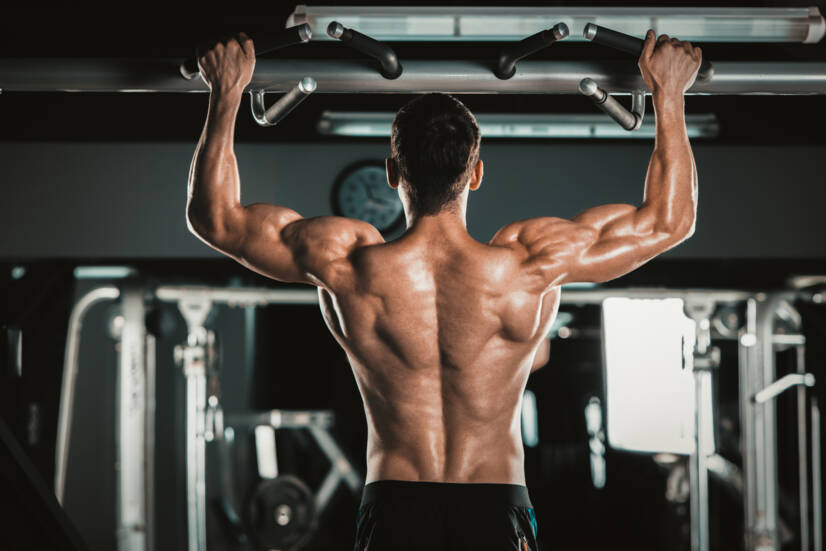
The back is the largest muscle group in our musculoskeletal system. It is the basis of many movements and keeps our body upright. What exercises are best for strengthening them and how to do them correctly?
Article content
At the same time, we would have to know the worst.
It all depends on how we approach it ourselves.
The back is a large muscle group. That means it also contains a large number of muscles.
When it comes to strengthening them, it depends on each one.
It's not good to neglect any of them.
But basically, there is no isolated exercise for every single muscle of the back. This is important to know.
Also, when strengthening the back, different muscle groups are involved in the exercise.
With one exercise, we exercise more than one muscle.
Muscular system
Let's start with a little lesson about our muscular system.
It is made up of muscles that make up about 30 to 40% of our body weight in adulthood.
The muscle itself is made up of three basic components:
- muscle fibres - active and capable of contraction, i.e. contraction.
- ligaments - these are the attachments of the muscles, they wrap around the muscle fibres
- the auxiliary devices of the muscles, blood vessels and nerves
The basic functional unit of a muscle is its fibres, which are joined together in bundles. The ligaments then attach the muscle to the bone by tendons.
This is called a muscle tendon.
Striated (skeletal) muscles are divided into two types according to their function.
Postural - Their main function is to keep the centre of gravity and the body in a stable position. They are the largest muscle groups of the trunk and limbs. They contain more red muscle fibres. They are characterised by slow contraction. They have high endurance. They tire only after all energy reserves have been exhausted. They perform activities that require a large and prolonged expenditure of energy. Thus, in endurance activities such as long-distance running, cycling, swimming, etc.
Phasic - They are functional in forward movement and provide fine coordination. They contain more white fibres. They are characterized by faster contraction and also greater strength and firmness. It is thanks to these fibres that our muscles have more volume. They contract quickly and therefore get tired quickly. Therefore, they are involved in short and intense exertion such as sprinting, weightlifting, swinging or punching.
Depending on the function of the muscle, it depends on which type of fibers it contains more of. Basically, however, every muscle contains both types of muscle fibers.
Some more, others less.
The basis of a muscle's activity is its contraction, or contraction.
We divide this activity into three types.
Concentric - When the muscle contracts, it shortens and contracts. The resistance of the external force is less than the effort the muscle must exert.
Eccentric - The resistance of the external force is greater than the effort the muscle has to exert. The muscle only adds to its effect. In this case, the muscle actually lengthens as it contracts.
Isometric - The external resistance and the muscular effort are equal. Although the muscle is tense, there is no movement at all.
By these actions we can also determine the type of training. In this way we will stimulate and activate our muscles.
They are in constant tension, even though we are theoretically doing nothing.
This tension is called muscle tone, i.e. resting tension.
It serves to maintain the functions of our body. It affects the functioning of internal organs, circulation and overall posture.
The stronger and larger the muscle, the higher its tone.
And one more pleasing thing for those who are trying to reduce their weight.
In this case, too, strength training is essential.
The bigger the muscles are, the more energy they need to work. This also burns more sugars and fats.
Don't worry, we won't get a Rambo-like physique just because we strengthen our muscles.
Back muscles
If we are going to exercise our back muscles, we should know something about them as well.
There are not a few. We'll talk about the important ones.
The back muscles are located in several layers along the spine, from the head to the tailbone.
They are divided into superficial and deep.
Superficial back muscles
They are located in three layers and are divided into two groups.
The limb (spinohumeral) muscles extend from the spine and attach to the scapula, clavicle or humerus.
The thoracic (spinocostal) muscles also extend from the spine but attach to the ribs.
The upper layer consists of:
- trapezius muscle (musculus trapezius)
- the broad muscle of the back (musculus latissimus dorsi)
Underneath these are:
- the small rhomboid muscle (m. rhomboideus minor)
- the large rhomboid muscle (m. rhomboideus major)
- scapular elevator (m. levator scapulae)
The third layer consists of:
- posterior serratus superior (m. serratus posterior superior)
- posterior serratus posterior inferior (m. serratus posterior inferior)
The trapezius is the superficial muscle of the spinohumeral group. It forms the outline of the shoulders. It is a flat muscle with a triangular shape.
It pulls the scapula down and against the spine. It allows the scapulae to be pressed together. It also allows the shoulders to be lifted.
The broad muscle of the back is the strongest muscle in our entire muscular system. It is also a member of the spinohumeral group. It is a flat, triangular-shaped muscle that occupies the lower half of the back. It lies superficially except for its upper part, which is hidden under the lower part of the trapezius.
It allows the shoulder to be pinned, tucked and pronated. This is the inward rotation of the shoulder so that the palms of the hands are facing backwards or downwards. The opposite of pronation is supination.
This muscle is also one of the main muscles involved in swimming or climbing movements.
It also helps as an accessory muscle in breathing.
Underneath the trapezius is the small and large rhomboid muscles. They form a kind of unit.
Their function is to lift the scapula up and pull it towards the spine.
The scapular elevator, as its name suggests, is used to elevate the scapula and bring it closer to the spine. It also helps with the curvature of the cervical spine.
The upper back sawtooth muscle serves as an accessory muscle during inspiration and lifts the ribs.
The lower posterior sawtooth muscle assists in exhalation, fixes the ribs and thus helps the diaphragm function as the main breathing muscle.
Deep back muscles
These are a set of serially arranged groups of small muscles. They are arranged from the head to the pelvis in parallel on either side of the spine.
Hence their function.
If they contract on both sides at the same time, they serve as the erectors of the spine. This group of muscles is therefore also referred to as the erectors of the trunk (musculus erector trunci).
If they contract only on one side, the spine is tilted to the side of the contraction, i.e. the muscles contract.
According to their course and function, they are divided into four systems.
The spinotransversal includes the muscles: m. splenius, m. longissimus, m. iliocostalis. If they are involved bilaterally, they ensure the erection of the spine and the tilt of the head. If they are involved unilaterally, the trunk tilts and rotates to the side of the active muscle.
Spinospinal: m. spinalis. Elevates the spine.
Transversospinal: m. transversospinalis - m. semispinalis, mm. multifidi, mm. rotatores. When engaged bilaterally, it straightens the spine. When engaged unilaterally, it causes a flexion to the side of the muscle and rotation to the opposite side.
Another system is the short dorsal muscles. Mm. interspinales help in flexion, mm. intertransversarii in adduction.
The deep layer of the back muscles also includes the deep muscles of the neck, called the suboccipital muscles. They are involved in the balancing movements of the head and upper cervical spine. They are also involved in the twisting, bowing and rotation of the head.
The following table shows the distribution of the back muscles
| Muscles of the back | ||
| Superficial muscles | First layer | m. trapezius, m.latissimus dorsi |
| Second layer | m. m. rhomboideus major, m. rhomboideus menor, m. levator scapulae | |
| Third layer | m. m. serratus posterior superior, m. serratus posterior inferior | |
| Deep muscles | Musculus erector trunci |
|
Back exercises
And we come to the exercises themselves.
Before we start exercising, it is good to know which exercises are a health risk for us.
It's important to consult a doctor to see if we can even do any of these exercises.
It is important to do the exercises correctly and not to overestimate your abilities.
When strengthening the back muscles, the muscles of other groups are also involved.
In particular, the muscles of the brachial plexus, upper limbs or pectoral muscles.
Movement patterns and physiological mechanisms of movement do not allow otherwise.
No muscle of the human body works in isolation.
Movement patterns are innate and encoded in our DNA.
Basic movement patterns:
- Squat
- forward bend
- lunge
- pressure
- deadlift
- rotation
- forward movement (walking, running)
We can build a full-body workout around these.
Read the article on how to make your own training plan.
What interferes with their functionality, however, are bad movement habits, called movement or dynamic stereotypes.
It is actually the execution of movement patterns with incorrect technique. We have become accustomed to it through physical development since childhood.
This can lead to injuries.
Pulling the upper pulley to the chest
Sedíme pod horní kladkou tak, že tyč je přesně nad naším čelem. Celými chodidly se opíráme o zem. Výšku sedadla nastavíme tak, aby stehna byla těsně pod opěrkou nohou. Uchopíme zahnuté konce tyče nadhmatem. Trup je vzpřímený, paže jsou plně natažené. Pohyb kladky směrem dolů začínáme nádechem a následným zadržením dechu. Rukama táhneme kladku dolů před hlavu, do úrovně ramen. Lopatky směřují k sobě. Během tahu kladky směrem dolů držte lokty směřující do stran v jedné linii s tělem. Vydechněte až při dokončení pohybu. V tomto bodě chvíli setrvejte (asi 1 až 2 sekundy). Pomalu a kontrolovaně vracíme tyč do původní polohy. Cvik opakujeme, dokud nedosáhneme úplného propnutí paží. V tomto okamžiku se opět na chvíli zastavíme.
This was one repetition.
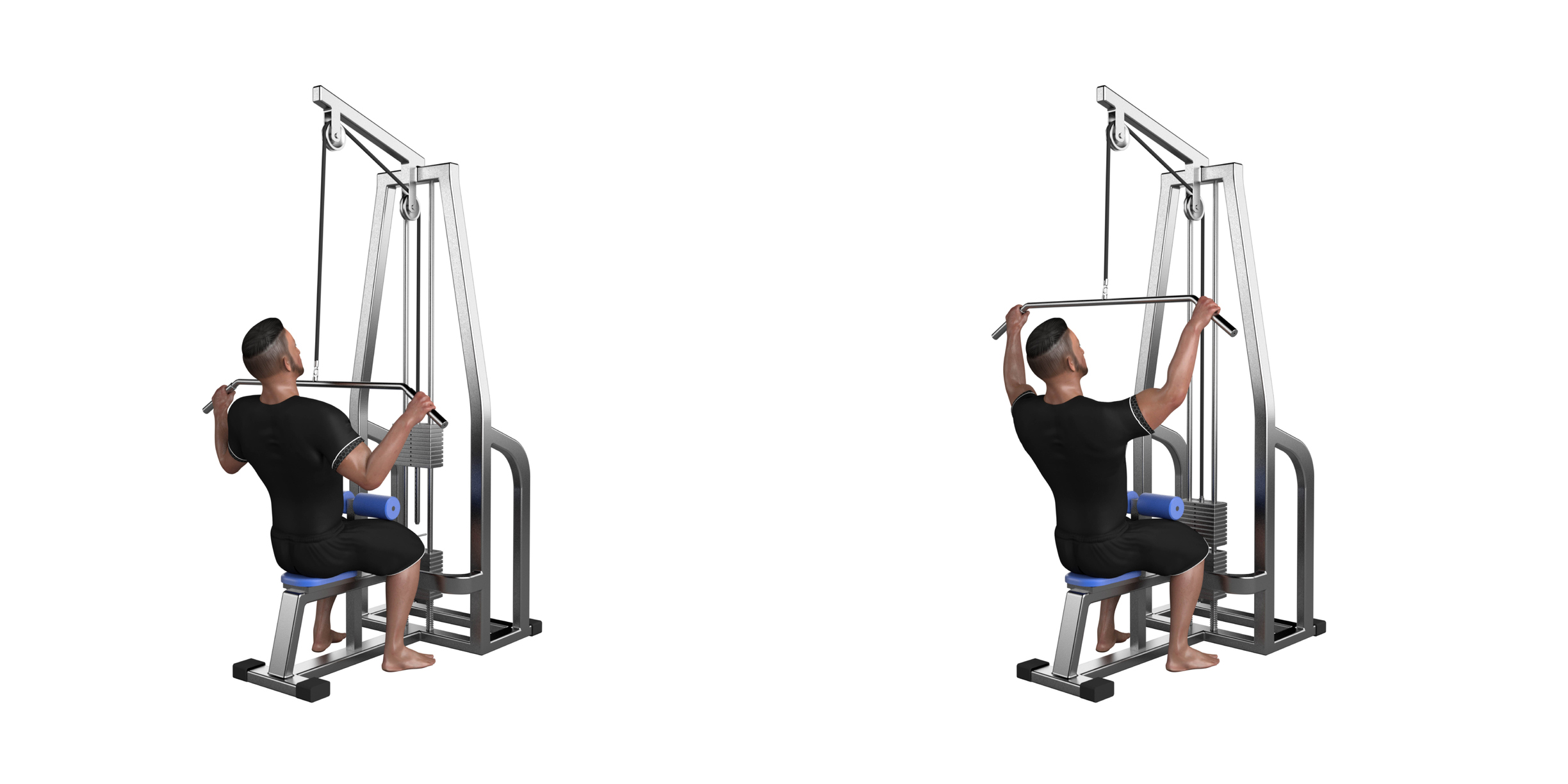
What to focus on?
- For full range of motion, the arms should be fully extended and the shoulders lifted.
- Ensure that you develop the upper back muscles by making your grip at least 25 cm wider than your shoulders
- a narrower grip means more strain on the muscles of the lower back
- keep your torso upright throughout the movement
- if we bend down when pulling the bar down, the back of the deltoid muscle and the lower part of the broad back muscle are activated
- Pull the bar of the pulley up to shoulder or upper chest level.
- the movement is performed in front of the head to ensure full range of motion and to spare the shoulders
- the supination grip, with the palms facing the body, is only used if the upper biceps and lower back muscles are to be exercised
- in the wide overhand grip, the biceps of the hand only stabilises the elbow joint and does not pull the pulley down
Which muscles are we exercising?
The broad back muscle (m. latissimus dorsi) is the main one, and the upper part of it. Other back muscles that come into play are the large and small rhomboid muscles (m. rhomboideus major and menor). Other muscle groups are also involved. The lower part of the large pectoralis major muscle (m. pectoralis major), which is the largest muscle on the front of the chest. From the brachial plexus, the large rounded muscle (m. teres major) and the small pectoralis minor muscle (m. pectoralis minor) help.
For which sports is this exercise relevant?
Stretching the back and strengthening the muscles of this area is of great importance for bodybuilders. In sports where the upward thrust of the body plays a major role, such as rock climbing and sport climbing. In gymnastics, it is essential for exercises on rings, bars and on the trapeze. In basketball for pulling the ball downwards. It is an effective exercise for swimmers because it resembles the pulling phase of swimming shots.
Shrugs on the trapeze
Grip the trapeze bar or horizontal bar with an overhand grip. Hands slightly more than shoulder-width apart. Hanging by them, we extend our upper arms through them. We inhale. With breath held, we pull ourselves up to the trapeze bar. We get to the point where our chin is level with the trapeze bar or slightly above it. Along with exhaling, we lower our body in a controlled manner to the starting position.
That was one repetition.
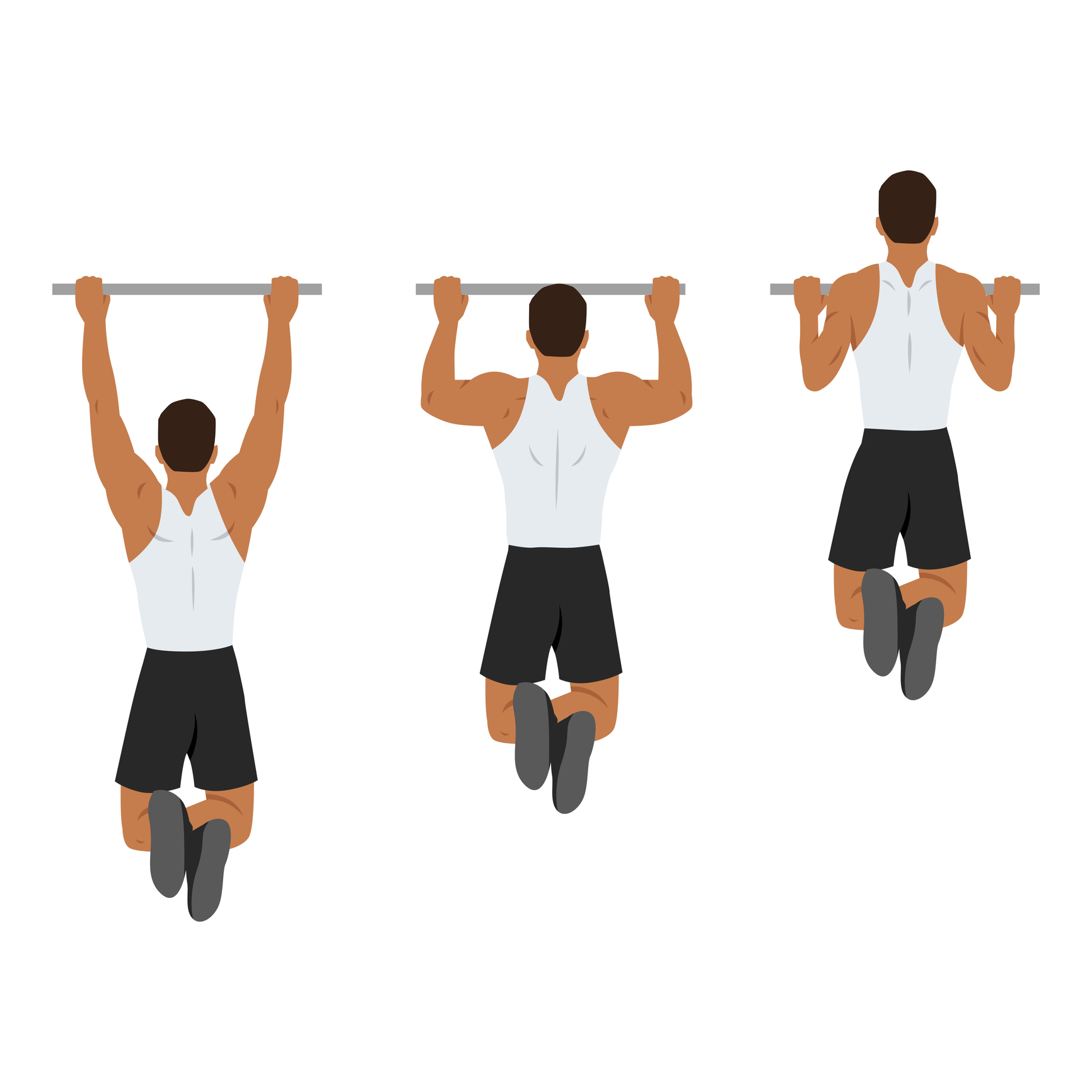
What to focus on?
- Bringing the chest close to the trapeze without the body swaying
- focus on working the back muscles - the biceps should not be involved, just hook the arms
- the wider the grip you choose (as wide as you can make it), the more effect it will have on the upper back muscles and their extension
- a narrower grip means a greater effect on the lower back and pectoral muscles
- Bringing the chin closer to the trapeze while moving the elbows to the sides gives a greater range of motion
- do not tilt the head and back under the trapeze, this reduces the range of motion and effectiveness of the exercise and increases the risk of injury
- if we can't do this, use a sparring partner to help us to support the lower limbs
Which muscles are we exercising?
First of all, the upper part of the broad back muscle (m. latissimus dorsi). Next, we engage the lower part of the pectoralis major muscle (m. pectoralis major) and the large rounded muscle (m. teres major), which are part of the brachial plexus muscles. They are supported by the subscapularis muscle (m. subscapularis), which is one of the muscles of the shoulder. Then the hook muscle (m. caracobrachialis), the short head of the biceps and the long head of the triceps, which are part of the upper limbs.
For which sports is this exercise relevant?
In bodybuilding, to extend the back muscles. In activities performed with an overhand or neutral grip (palms together), associated with pulling. Often performed in sport climbing or mountaineering. In gymnastics, when performing exercises on the trapeze, bars or rings. In swimming, in all swimming styles, but especially in the sign or butterfly.
Pulling the top pulley with the arms outstretched
Postavte se čelem asi 30 cm od horní kladky. Nadhmatem rukama uchopte tyč. Ruce máme od sebe asi na šířku ramen. Měli bychom být v takové poloze, aby naše paže byly mírně pokrčené v loktech. Hlava směřuje dopředu asi 20 stupňů od svislé osy. Nadechneme se. Začneme stahovat kladku dolů. Naše paže jsou po celou dobu pohybu natažené. Tah vychází z ramen. Pokračujeme až do úrovně boků. Svaly dolní části zad držíme napnuté, tělo je po celou dobu natažené. Ve spodní poloze setrváme asi 1 až 2 sekundy. Vydechněte, když se tyč kontrolovaně vrací do původní polohy. Zde se na chvíli zastavíme, než budeme pokračovat v dalším opakování.
That was one repetition.
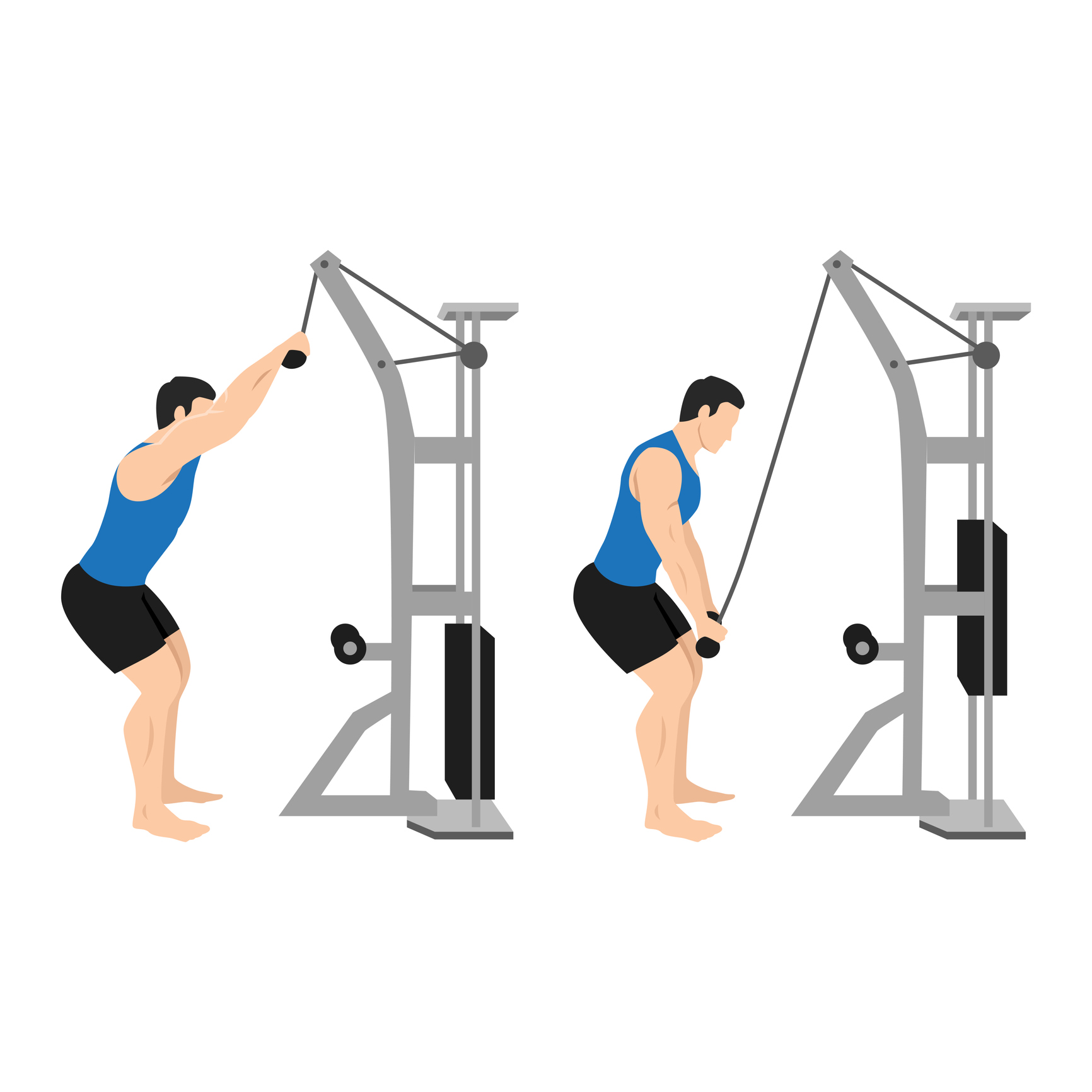
What to focus on?
- Start the movement with your elbows slightly bent to exercise your lower back muscles.
- with very bent elbows, the effect is transferred to the upper back muscles
- we must start with the arms above the head - with the arms at shoulder level, the back muscles will tend to work only in the lower part of the movement
- keep the torso extended throughout the exercise
- a slight forward bend can help us pull the pulley down more easily, but may reduce the load on the muscles being exercised
- it is better to use lighter weights so that we don't have to bend our elbows when performing the exercise, thus changing the effect of the exercise on the broad back muscle
- when pulling down, inhale and hold your breath, when returning the bar to its original position, exhale
- if we exhale when pulling the bar down, the stability of the trunk would be reduced and thus the effectiveness of the exercise would be reduced
Which muscles are we exercising?
The arms are almost stretched out during this exercise. Therefore, the greatest load is transferred to the broad back muscle (m. latissimus dorsi), whether the grip is wide or narrow. The second layer of upper back muscles is the rhomboid muscle, both large and small (m. rhomboideus major and minor). Then there is the large round muscle (m. teres major), the small pectoralis muscle (m. pectoralis minor), and all the muscles of the brachial plexus.
For which sports is this exercise suitable?
Bodybuilders develop the structure and volume of the lower pectoral muscles and the lower and upper back muscles. Swimmers find it useful in the crawl and butterfly styles. Gymnasts use it in exercises where the arms are pulled down from above. Basketball players use it to push the ball downwards. American football players use it to stop and defend their opponents. Climbers and sport climbers cannot neglect it either.
In this article you will read about nutritional supplements.
Pulling the dumbbell in a forward bend overhand grip
Nohy máme od sebe na šířku ramen. Uchopíme činku ležící před námi nadhmatem s rukama mírně dále od sebe, než jsou naše ramena. Zvedneme se do vzpřímené polohy s nataženýma rukama. Mírně pokrčíme kolena a ohneme se v pase do úhlu asi 30 stupňů s podlahou. Trup máme natažený. Hlavu držíme mírně vzhůru. Paže visí s činkou před tělem. Právě jsme zaujali výchozí pozici. Nadechneme se a zadržíme dech, zatímco činku přitahujeme kolmo k tělu. Lokty při tomto pohybu směřují dozadu a nahoru podél těla. Snažíme se je dostat nahoru nad úroveň trupu. S výdechem činku kontrolovaně spouštíme do výchozí polohy.
That was one repetition.
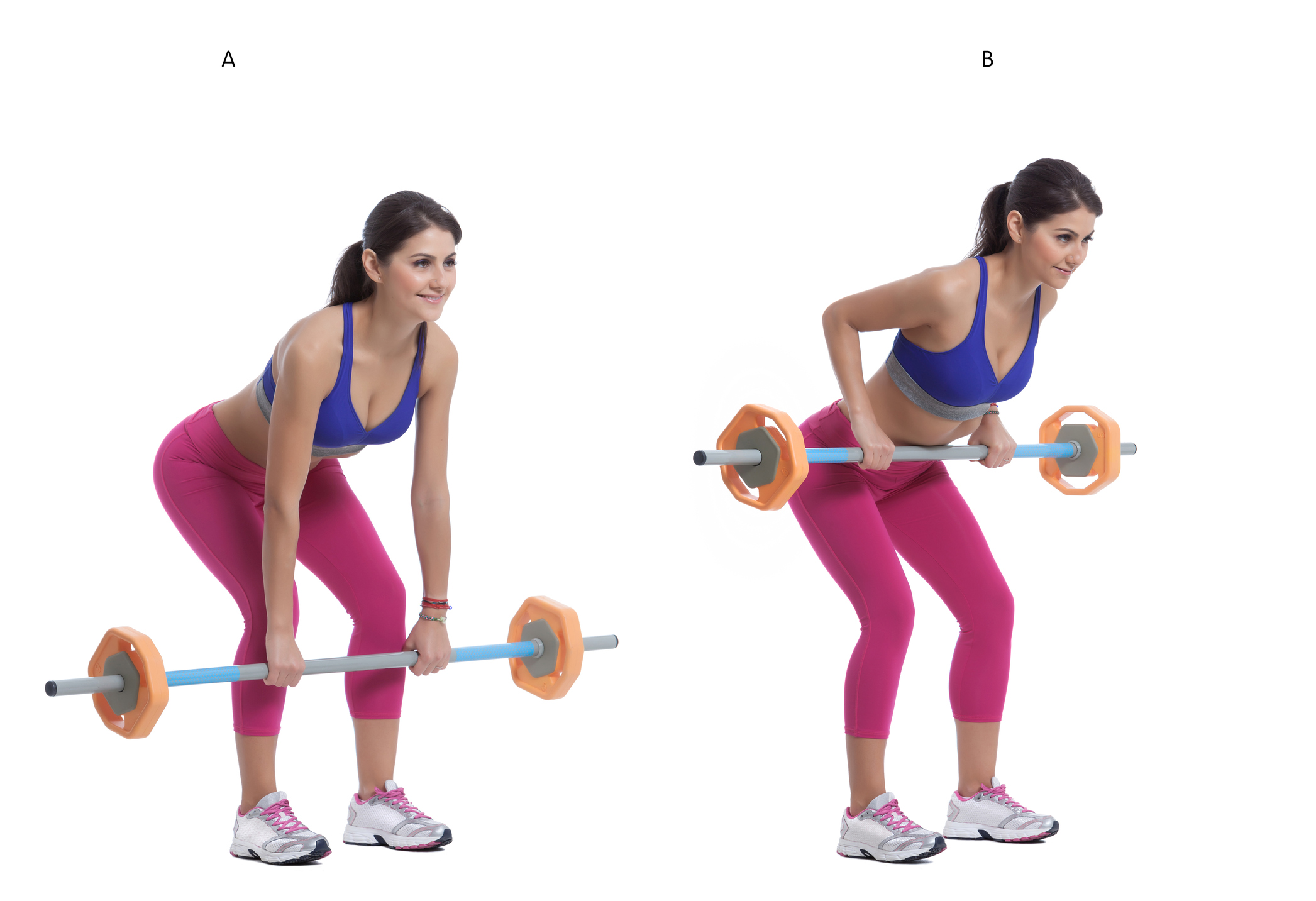
What to focus on?
- Try to maintain a 30-degree trunk tilt throughout the movement, especially in the pull phase.
- for stability, we need to keep our feet slightly further apart, not the other way around.
- concentrate on engaging the deltoid and back muscles
- the width of the dumbbell grip must be at shoulder width or slightly more, this will ensure full range of motion and lift the elbows to above the plane of the back
- the more the elbows are raised, the more effective the exercise is
- keep your back straight, as movement of the torso during the exercise is dangerous
- the same applies to pulling the dumbbells with a rounded back in conjunction with a backward trunk movement
- do not use excessive loads - it causes cheating, i.e. impure execution of the swing exercise and reduction of the range of motion
- keep the knees slightly bent
- over-extended legs result in a rounded back, increasing the risk of injury
- a harder version of the exercise is achieved by keeping the elbows more to the side throughout the movement and pulling the dumbbell more towards the chest than the waist - then you will also notice a different muscle involvement, namely the back of the deltoid, the middle of the trapezius and the broad back muscle
- if we grasp the barbell underhand, we concentrate our efforts on the broad back muscle (m. latissimus dorsi), the large rounded muscle (m. teres major), the posterior head of the deltoid muscle (m. deltoideus) and the middle part of the back
Which muscles are we exercising?
The broad back muscle (m. latissimus dorsi) is the most involved, and from the brachial plexus the large round muscle (m. teres major) and the posterior head of the deltoid muscle (m. deltoideus - pars posterior). However, the latter is already involved to a lesser extent. From the second layer of the upper back muscles, the small and large rhomboid muscles (m. rhomboideus major and menor) are involved. Let's not forget the middle part of the trapezius muscle (m. trapezius), which is also involved from the group of upper back muscles.
For which sports is this exercise relevant?
In bodybuilding, it develops the broad back muscle, the posterior deltoid muscle and the mid-back. The action of the muscles involved in this exercise is necessary in the downward and backward movements of the upper limbs. This means that in gymnastics it finds application, for example, in exercises on the rings, bars or trapeze. In basketball, when moving with the ball. In balancing, rowing, swimming, especially in the later stages of the shot. Other sports are wrestling, judo, American football. In mountaineering and sport climbing, it helps in the upward thrust of the body.
Pulling the lower pulley in a seated position
Sedíme čelem ke spodní kladce, ke které jsme připevnili dvojitý držák. S nohama mírně pokrčenýma v kolenou položíme chodidla na podpěru. Pokrčíme se v kyčelních kloubech a uchopíme držák. Záda jsou normálně prohnutá. Začněte tahat trup dozadu, dokud nebude natažený a kolmý k podlaze. Paže jsou plně natažené. Právě jsme zaujali základní polohu. Nadechneme se a se zadrženým dechem přitáhneme držák k trupu, přibližně na vrchol břicha. Lokty jdou rovnoběžně s rovinou těla. Držme je co nejblíže. Táhneme kladku, dokud lokty mírně nepřečnívají rovinu trupu. Během pohybu se nepředklánějte ani nezaklánějte. Tah provádějte pouze rukama. V této poloze setrvejte 1 až 2 sekundy s výdechem a kontrolovaně se vraťte zpět.
This is one repetition.
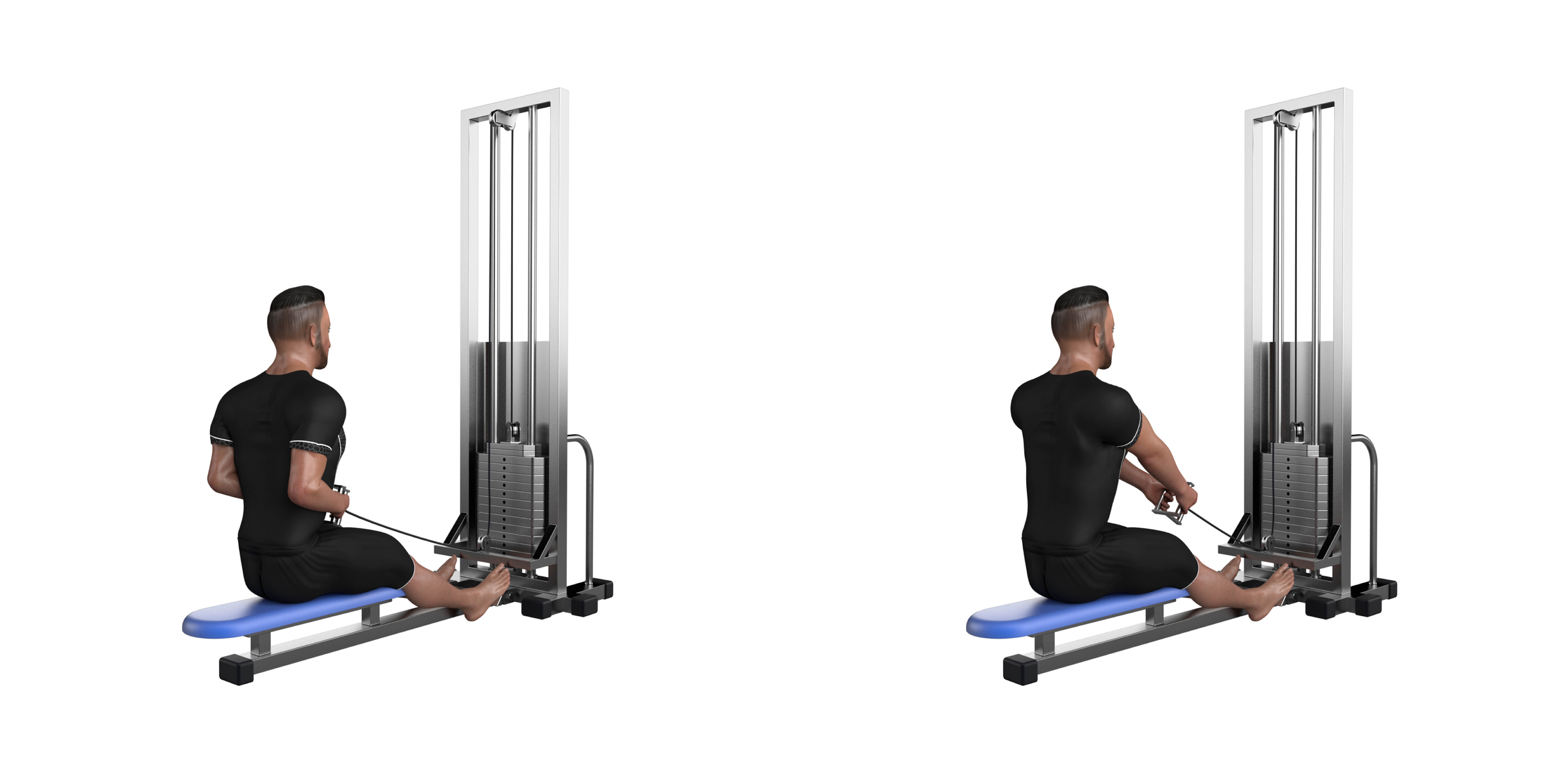
What to focus on?
- Keep the body upright, allowing a maximum of slight back and forth movement (about 10 degrees) to ensure full muscle contraction
- Concentrate on pulling with the back and deltoid muscles, do not use the torso to pull
- keep the back naturally arched - if we arch it too much when moving forwards and arch it too much when moving backwards, we overload the back and strain the intervertebral discs, leading to injury
- do not pull the elbows on the bar - this would exercise the biceps of the upper limbs and reduce the effect on the back muscles
- maintain a constant position of the lower limbs, do not stretch or bend them during the exercise
- the heavier version of the exercise, which exercises the upper back, is performed in a pronation grip, i.e. overhand grip, with the palms facing downwards
- then accentuate the action of the back of the deltoid head, the middle part of the trapezius and the rhomboids
Which muscles are we exercising?
In the initial phase of the exercise, the lower part of the broad back muscle (m. latissimus dorsi) is the main muscle involved. Next, the middle part of the trapezius muscle (m. trapezius). From the second layer of superficial muscles of the back, the rhomboid muscle (m. rhomboideus). From the brachial plexus, the large round muscle (m. teres major) and the posterior head of the deltoid muscle (m. deltoideus - pars posterior). From the posterior muscles of the upper limb, the long head of the triceps brachii (m. triceps brachii - caput langum) is used. The large pectoralis major muscle (m. pectoralis major), which belongs to the group of chest muscles, also plays an important role.
For which sports is this exercise important?
Bodybuilders use it to develop the broad back muscle, the large rounded muscle and the mid-back. These muscles and movements are important in activities that require pull-ups from a central position in front of the body. They find use in rowing and paddling. In gymnastics, when doing the circle routine. In judo, in the preparatory phase before the snatch. In swimming, especially in the cartwheel and butterfly. In wrestling, when attempting to push the shoulders off the mat.
Pulling a one-armed dumbbell in the prone position
Postavte se vedle rovné lavičky nebo jiného stabilního předmětu. S chodidlem blíže k lavičce udělejte krok a zaujměte pozici výpadu. Postavte se bokem k lavičce. Bližší noha je ve výpadu, druhá je vzadu. Předkloňte se tak, aby byl trup rovnoběžně s podlahou. Kolena máme mírně pokrčená. Dlaň ruky bližší k lavičce se o ni opírá. Ta nám zajistí stabilitu. Pokud se v této poloze necítíme dobře, můžeme bližší nohu položit celou holení na lavičku. V takovém případě na ni přeneseme část své váhy. Volnou rukou uchopíme jednoruční činku dlaní k tělu. Jedná se o tzv. neutrální úchop. Ruka visí volně směrem k zemi. Paže je uvolněná. Nadechneme se a se zadrženým dechem vytáhneme činku nahoru. Činku táhneme podél těla, dokud není ve vodorovné poloze. Současně vydechujeme. Když je loket co nejvýše, snažíme se paži mírně zvednout, abychom dosáhli větší kontrakce procvičovaných svalů. V této poloze chvíli setrváme, asi 1 a
This is a unilateral exercise, so work each side separately. After completing the set number of repetitions with one arm, switch sides and repeat with the other upper arm. This completes one set.
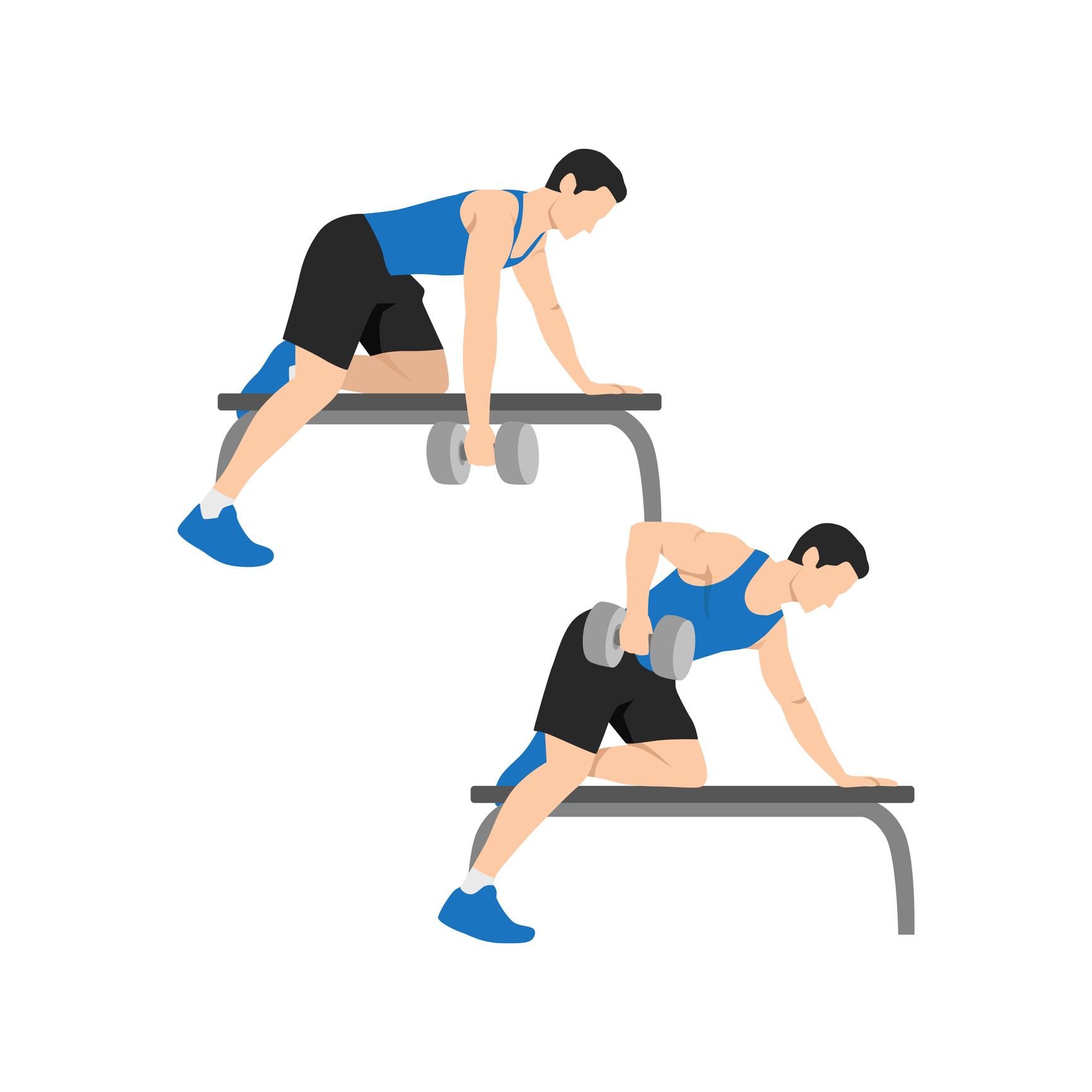
What to focus on?
- Focus on a strong arm stroke that allows us to perform the full range of motion and engage all the muscles involved.
- when we reach the top position, lift the working arm only slightly and keep it and the back horizontal
- the use of large weights limits the range of movement
- if we get the elbow above body level, the muscles being exercised contract more
- if we want to target the upper part of the broad back muscles and the upper mid-back, we use a pronation grip, then the palm faces backwards and the elbow away from the shoulder plane
- by placing the shins on the bench, we may have less stability - there is an increased tendency for the muscles to relax and therefore the possibility of injury
- we concentrate only on the muscles of the shoulder and back without using the biceps of the upper limb
Which muscles are we exercising?
The first layer of superficial muscles consists of the broad muscle of the back (m. latissimus dorsi) and the trapezius muscle (m. trapezius), from the brachial plexus, the large and small rounded muscles (m. teres major and minor), the posterior head of the deltoid muscle (m. deltoideus - pars posterior) and the subscapularis muscle (m. infraspinatus). From the second layer of superficial muscles, the rhomboid muscle (m. rhomboideus).
For which sports is this exercise relevant?
For bodybuilders, it is necessary to properly develop the broad back muscle, the large round muscle and the middle part of the back muscles. It is necessary to use the neutral and pronation grip. In gymnastics, it is suitable for exercises on rings and on the trapeze. In mountaineering or sport climbing, it can be used when pulling the body up or climbing on a rope. The downward and backward grip can also be used in swimming, especially in the second phase of the grip. In archery or rowing, when doing the backward grip. In basketball, when moving the ball, in wrestling or judo. The rowing movement is also used in sports played with a racket when doing the backward grip or in American football when throwing the ball.
Pulling the bar to the chest
For this exercise, use a special machine or an inclined bench at about a 45-degree angle. Rest your chest and abdomen against it and use a large dumbbell, a one-handed barbell or a so-called T-bar. It can also be practised standing, in a slight forward bend, without resting on your chest.
We lean our chest against the back of the machine. Our feet are either on the footstool or with the toes on the floor. We reach out and grasp the handle in whatever position it allows us. Either neutral (with the palms facing the body from the side) or pronated (overhand). In this case, they face the body from the front. We inhale. With bated breath, we pull the bar towards the chest until the elbows are above the level of the torso. We try to keep them as close to the body as possible. From this point on, we lower the bar to its original position with an exhale.
This is one repetition.
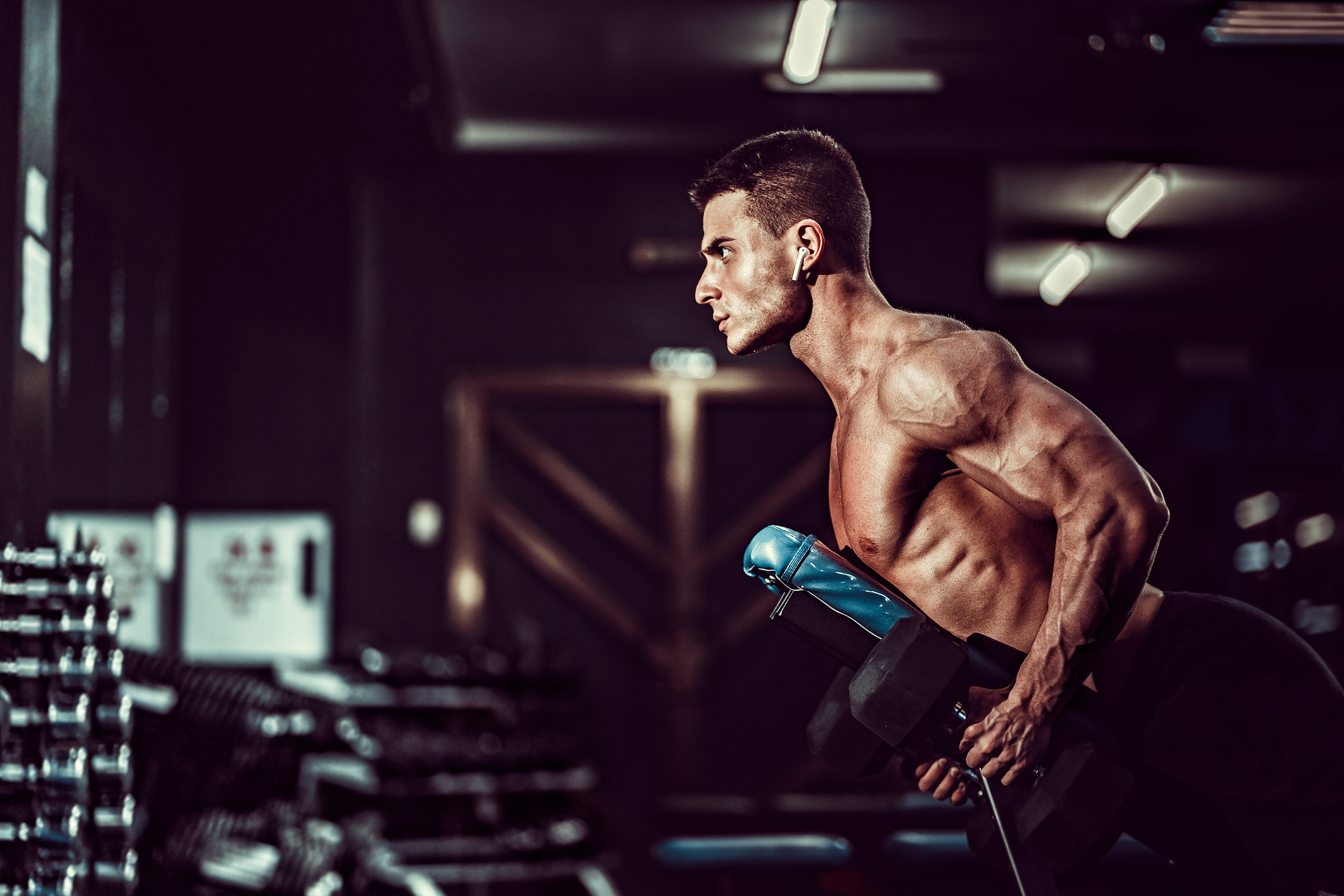
What to focus on?
- not using excessive weight, which will allow us to get the elbows as high as possible and push the shoulder blades as close together as possible - this will engage the rhomboids and the middle part of the trapezius muscles more
- we must be in a stable position when exercising, we must not move our body - this increases the risk of injury
- concentrate on working the back and deltoid muscles, not the biceps
- fully extend the arms before each repetition to allow the muscles to work sufficiently
- hold the bar in the upper position for about 1 to 2 seconds for greater contraction, but don't stop for a moment in the lower position
- the pronation grip mainly involves the upper part of the broad back muscle, the back head of the deltoid muscle, the middle part of the trapezius and the rhomboids
Which muscles are we exercising?
The first layer of superficial back muscles are the broad back muscle (m. latissimus dorsi) and the trapezius muscle (m. trapezius). Below these, from the second layer, the rhomboid muscle (m. rhomboideus) helps. From the brachial plexus, it is the large rounded muscle (m. teres major), which is supported by the posterior head of the deltoid muscle (m. deltoideus - pars posterior).
For which sports is this exercise relevant?
Bodybuilders find it useful for developing the muscles of the upper back. This activity is useful for improving the ability to lift a load from the ground towards the body. It is useful in rowing or paddling. In all types of movements in which the body is lifted to a height, and in climbing. In acrobatics and in gymnastics in circle exercises. In swimming, especially in the cartwheel and butterfly. In judo in gripping and pulling an opponent. In American football in stopping an opponent. Also in movements similar to cutting wood.
Interesting resources
Related










